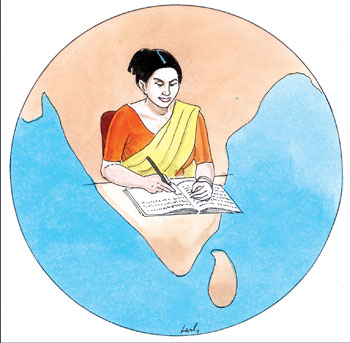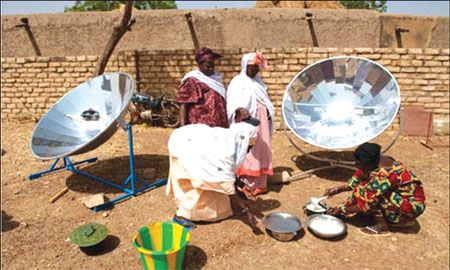|

Sensibility knows no gender difference
South Asian women writers:
 The
general misconception, probably created by the male of the species, is
that literature is dominated by men writers all over the world. The
truth is, the theme of women writers is too vast to be discussed within
a limited space. The
general misconception, probably created by the male of the species, is
that literature is dominated by men writers all over the world. The
truth is, the theme of women writers is too vast to be discussed within
a limited space.
Daya DISSANAYAKE
In a supposedly male dominated literary world it is Enheduanna who is
still accepted as the first writer among ‘man'kind. In South Asia, there
have always been women writers, of equal prominence as the males.
Though this article is about women writers, the approach is not from
a ‘Feminist’ view, because feminism is an alien concept to the South
Asian culture. Women always had an equal or a dominant position in our
cultures, and even in pre-historic cultures throughout the world. The
myth about a hunter-gatherer and provider of the family has been
exploded and there is evidence to believe that the woman was the
provider of all food and who took care of the family. The men were only
there for protection and to provide an occasional supply of meat from a
hunted animal. Contradicting the myth about the subservient position of
women in South Asia, we find numerous inscriptions of donations of caves
and temples made by women.
However, when readers and even scholars discuss South Asian women
writers, they always take up the role of post-colonial writers, talking
about how they have moved away from “traditional enduring,
self-sacrificing women searching for identity”. But that is because
these readers are only exposed to the diasporic writings and writing in
English. Had they been aware of real “indigenous” writing by women in
South Asia, they would have realized the true position of these women
and their role in culture and arts.
 It should be noted that the Asian woman did not consider her domestic
responsibilities as a burden, as “chores”, but she did it out of her
love and devotion for her family. It is the ignorant and conceited men
who considered that the women were slaving on their behalf, because the
women were inferior. It should be noted that the Asian woman did not consider her domestic
responsibilities as a burden, as “chores”, but she did it out of her
love and devotion for her family. It is the ignorant and conceited men
who considered that the women were slaving on their behalf, because the
women were inferior.
The oldest surviving women writing from South Asia are accepted as
the Therigatha from the 6th century B.C. There could have been previous
writings, which have not survived, or had been suppressed or destroyed
by their male rivals.
However, there is a school of thought that some of the Vedic hymns
were written by women. Among them is Ghosha, the granddaughter of
Dirghatamas and daughter of Kakshivat, who were both composers of hymns
in praise of Ashwins. Ghosha has 14 verses in praise of Ashwins, another
was a personal prayer for married life after she is cured of her
lifelong ailment. Lopamudra was the wife of the sage Agasthya who is
credited with two stanzas in the Rig Veda. Maitreyi, one of
Yajnavalkya's wives, had written 10 out of the Rig Veda hymns. Gargi,
daughter of sage Vachaknu, was also a Vedic prophet (or should we call
her a prophetess?)
Sangam Age (100 B.C. to A.D. 250) writings are considered the oldest
South Asian secular poetry, and out of the 2,381 surviving poems 154 are
by women. Susie Tharu and K.Lalita believes that most of the anonymous
works would also be by women. In the West sometimes women had to write
under male names. Even Joanne Rowlings had to appear in a more masculine
guise as J.K. Rowlings. In Sri Lanka it once happened the other way
round, when Alexander Welivita write under the name Swarnalatha Vaduge
Kumarihami. (Palliyaguru & Kularatne).
The oldest university on earth, founded at Nalanda around the 1st
century B.C. gave women equal status, but any writing made by them were
destroyed when the university was burned down.
The seventh century poet Vijjaka or Vidya from the present day
Karnataka has written “without knowing about me, Vijjaka, dark, like the
petal of the blue lotus,
That the poet Dandin (vainly) said that the Goddess of learning was
all white”.
In the ninth century, Avantisundari, wife of the poet Rajasekhara,
had written poetry in Prakrit. Rajasekhara had written in ‘Kavya
Mimamsa’, “women also can be poets. Sensibility and sophistication know
no difference of sex”. Hemachandra used quotations from Avntisundari in
his Deshiamamala in the twelfth century.
The Tamil poet Karraikal Ammaiyar is the earliest of the women-poet
saints
of the Bhakti movement. Bhakti poets wrote in their regional
languages, breaking the religious and literary hold of Sanskrit. Many of
the Bhakti poets were women, among them 12th century poets, Akkamahadevi
and Sule Sankavva, who “wrote poetry that could startle contemporary
sensibility with its combination of the sacrosanct and the sacrilegious”
(Vijaya Dabbe) Janabai, who belonged to the Sudra community, orphaned at
a young age, became a servant in the household of a Varkari devotee, and
later became the ‘dasi’ of a son of the family. Yet she wrote over 340
devotional songs, which survived as her master Namdev, who himself was a
Varkari poet, saved them.
She considered her god ‘Vitthal’ (an incarnation of Vishnu), as her
mother, her fellow servant and ultimately as herself. In one poem she
addresses her God Vitthal,
“You leave your greatness behind you,
to grind and pound with me.
O Lord you become a woman,
washing me and my soiled clothes,
proudly you carry the water
and gather dung with your own hands”
The Bhakti movement was spread all over the Indian subcontinent.
Janabai wrote in Marathi. Rami wrote in Bangali, Gangasati and Ratnabai
in Gujarati, Atukuri Molla in Telugu and Gul-badan Begum in Persian.
Some of the well known women in Kannada literature include Triveni,
(1928 - 1963), Rajalakshmi N. Rao (Sangama), N. V. Bhagyalakshsmi
(Berala Sandiya Baduku), Vina Shanteeshwar (Higondu Kathe) Tahru and
Lalita discuss the issue of “Colonial Rearticulation of Gender”, when
“Women artists were delegitimated and marginalized”, like the Vishnava
poets. An extraordinary number of biographies had been written by women
in the late nineteenth and early twentieth centuries, mainly in Marathi
and Bengali, Pandita Ramabai, Lakshmibai Tilak, Rassundari Devi among
them.
Sarojini Naidu (1879 - 1949), born in Hyderabad, though well known as
a great poet, wrote in English, during her early years. Later she had
devoted her full time for politics and the Independence struggle. Rokeya
Sakhawat Hossain (1880 - 1932), born in Pairaband in present day
Bangladesh also wrote in English (Sultana's Dream, 1905). But Sughra
Humayun Mirza (1884 - 1954) and Janaki Bai (1889 - ?) wrote in Urdu.
 A list of 20th century South Asian writers could begin with Kuntala
Kumari Sabat who wrote in Oriya, Kamla Choudhry in Hindi, Ashapurna Debi
in Bengali, Lalithambika Antherjanam in Malayalam, and Shyamal Devi in
Kannada. A list of 20th century South Asian writers could begin with Kuntala
Kumari Sabat who wrote in Oriya, Kamla Choudhry in Hindi, Ashapurna Debi
in Bengali, Lalithambika Antherjanam in Malayalam, and Shyamal Devi in
Kannada.
In Sri Lanka the first women writers could be authors of the
Deepavamsa, the oldest known chronicle, which is claimed to have been
written by a team of Bhikkhunis. There is reference to the Twelve great
poets, and we do not know if any of them had been women. We know there
were many women who wrote poems on the Mirror like wall of Sihigiri.
The first woman writer in English in Sri Lanka is accepted to be
Rosalind Mendis (Mystery of a Tragedy). The Sri Lanka Directory of Women
Journalists and Writers lists 500 profiles of our writers. There could
be many more, who have not been listed, who have been here before our
time.
The place of Sri Lankan women writers in Sinhala has been
convincingly proven by Sumithra Rahubadda, Sunethra Rajakarunanayake,
and others, by consistently winning awards for their creative writing,
outclassing the male writers.
Women authors writing in Tamil include fiction writers, Kokila
Mahendran, Annaladchmy Rajadurai, Yoga Balachandran and Padma
Somakantahn and poets, Sivaramani, Urvasi, Maithayi, Sankari, Kasthuri,
Auvai and Zulfika. (Lakshman & Tisdell)
Pakistan women writing in Urdu include Alfat Fatima (Dastak Na Do),
Bano Quisia, Fatima Suraya Bajia, Fehmida Riaz, Haseen Moin and Umaira
Ahmad. Attiya Dawood writes in Sindhi. There are many more women who
write and publish for their readers in Pakistan, doing a silent service
for their arts and literature.
Taslima Nasreen is the most well known writer from Bangladesh, who
shot into the international limelight after ‘Lajja'. There are many
other women writers.
The first version of the Ramayana by a woman writer appeared in the
16th century, by Chandravati, paying tribute to Sita. This is the
Bengali Ramayana or Chandravati Ramayana, described through the lives of
Sita, Mandodari and Chandravati herself. Other writers are Mahasweta
Devi who won the Magsaysay award in 1997. Baby Halder, from West Bengal,
abandoned by her mother at 7, married off at 12, escaped to Delhi with
her three children. She wrote her memoir ‘A Life Less Ordinary’, which
has been translated into several languages including English.
Aminath Faiza (1924 - 2011) was a Malidivian poet who wrote in
Dhivehi, who was awarded the National Award of Recognition (1980) and
National Award of Honour (1996) for her contribution to Maldivian
poetry.
Kunzang Choden is from Bhutan, studied in Delhi and Nebraska. She
writes in English on Bhutanese oral traditions.
Manjushree Thapa was born in Nepal, lives in Kathmandu, but had
studied in Canada and her higher education in Washington, writes in
English.
A list of South Asian Women Writers is available at
http://www.sawnet.org/books/authors.php
It is time that men started writing and discussing Male writers too,
or someday they too would have to complain about being dominated by
female women writers.
[email protected]
Women should be focus of energy expansion plans- UN
Women should be the focus of efforts to bring access to modern energy
to those who lack it, a new United Nations report has found, as bringing
energy to women and girls helps lift communities out of poverty and
improves health.
But the report also warned that providing energy alone was not enough
to combat poverty, and programmes to provide energy access work best
when they are accompanied by help for people to access other key
services such as microfinancing and education.
Providing energy to the poor has long been seen as key to addressing
poverty levels, and over the last 20 years there have been scores of
programmes that attempt to bring energy services for lighting and
cooking to deprived communities, particularly in rural areas. But too
many of these have focused only on supplying access to villages, towns
and homes - often a question of just putting in the cabling or
generating equipment.
 |
|
Women
prepare food using a solar cooker in Mali. |
Martin Krause, leader of the climate and energy team for Asia Pacific
at the UN Development Programme (UNDP), said his study showed this was
not enough. “Energy services are often not affordable by the rural and
urban poor, and on their own have little impact.
The poor need support to generate income so that energy becomes
affordable, which in turn will improve household living standards.” He
called for the provision of “energy plus” services that would provide
access to sustainable and renewable energy sources but also assistance
for people to supplement their incomes and improve their education.
The UN has launched a new campaign called Sustainable Energy for All,
in an attempt to bring the benefits of cleaner energy access to poor
communities.
Currently, more than a fifth of people around the world have no
access to electricity, and twice that many rely on biomass - usually in
the form of wood, charcoal or animal waste - for cooking and heating.
The indoor air pollution from cooking fires leads to more than a
million deaths and many more cases of ill health every year.
Focusing on women is a way to cut this high number of deaths, and it
also frees up women and children from spending hours every day in the
hunt for fuel, a time-consuming task that is one of the reasons girls in
developing countries often spend less time at school than boys.
The soot from cooking fires is also a significant contributor to
global warming (pdf), according to a UN Environment Programme report
published last year, and cutting it could delay dangerous climate
change.
As part of the new UNDP report, entitled Towards an Energy Plus
Approach for the Poor, the authors studied 17 energy access projects in
the Asia-Pacific region to find what was successful.
They found that energy access programmes should be set up in
conjunction with other development initiatives such as microfinance,
transport infrastructure, telecommunications, schools and health
facilities, and that giving people access to renewable forms of energy
could also help to lift them out of poverty.
They pointed to success stories such as a solar lantern rental scheme
in Laos, providing cleaner and cheaper lighting than the kerosene lamps
they replaced.
Biogas from animal waste is also a key potential new technology. By
clubbing together, poor people can also gain better access - by ensuring
a minimum number of guaranteed customers, schemes encourage providers
such as solar panel-fitters to enter the market, for instance.
But the authors also found a clear role for regulation, pointing to
measures such as China's new laws stipulating more renewable energy,
which has led to a dramatic growth of clean energy across the country.
Access to energy alone is not enough to combat poverty, says UN
report, it needs to be allied with microfinance and education
programmes.
-Guardian.co.uk
|



